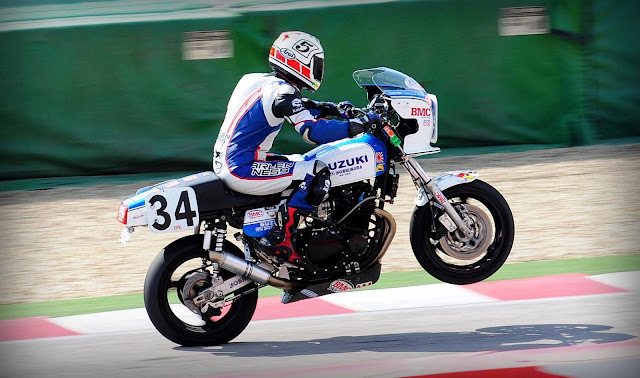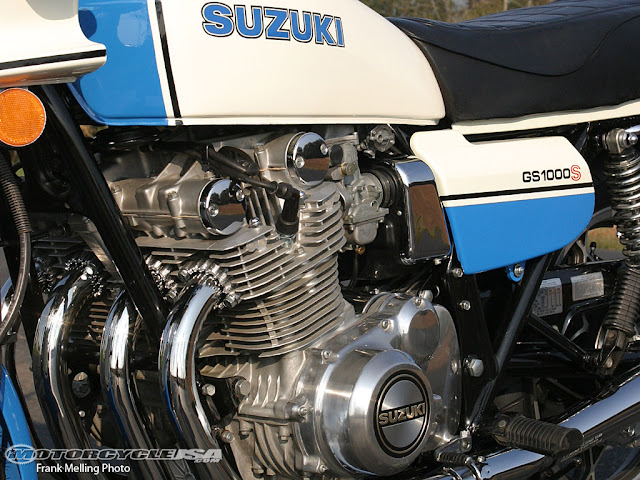Suzuki GS1000
Suzuki’s big four was a good-looking machine whose sty'le was very similar to that of the GS750 and 550 models, both of which had been launched one year earlier in 1977.
At first sight Suzuki’s GS1000 was an unlikely bike to be regarded as outstanding; let alone as a machine that would be regarded as an all-time great even decades after its arrival in 1978. Although pleasantly styled, the GS was unexceptional to look at. Its air-cooled, dohc four-cylinder engine design was entirely conventional, as was its steel-framed, twin-shock chassis layout.
But the GS1000 was extra special, for two main reasons. Firstly, it was slightly better in just about every quantifiable way than its direct rival, Kawasaki's Z1000 - meaning that Suzuki’s first ever open-class machine was the best big four on the road. More importantly, the GS could be ridden extremely hard without wobbles or weaves, which arguably made it the first Japanese superbike to match European levels of chassis performance.
Stability and cornering prowess
Coming as it did towards the end of a decade in which Japanese machines had gradually assumed dominance due to their powerful and reliable engines, without managing to shake off criticisms of second-rate chassis, the Suzuki’s arrival was significant. Here at last was a bike that was not only faster than any other four in a straight line, but whose stability and cornering prowess allowed - no, positively encouraged - its rider to make the most of all that power.
The achievement of Suzuki’s engineers was all the greater given that the firm’s first four-stroke multi, the excellent GS750, had itself been launched only one year earlier. The larger powerplant, which had a capacity of 997cc from dimensions of 70 x 64.8mm, followed the 750’s dohc eight-valve layout and actually weighed slightly less, due to features including a lighter flywheel, thinner crankcases and lack of a kick- starter. But the bigger motor was considerably more powerful, producing a maximum of 87bhp at 8000rpm that was I9bhp up on the GS750, and gave a 4bhp advantage over the Z1000.
The GS1000 shared its overall look and steel, twin-downtube frame layout with the GS750. But the new bike’s frame was thicker in places, and its tubular steel swingarm was stronger. The GS1000 also had wider tyres, plus an extra front brake disc. Its new forks were air-assisted, and its shocks could be adjusted through four rebound damping positions - giving the GS the most sophisticated suspension system yet seen on a mass-produced roadster. (So it did have some technical innovation, after all.)
This added-up to a stunning new superbike that seemingly had no real weakness, and which made the Z1000, until now the dominant big four, look slightly second rate. The GS stormed past the 1OOmph (161km/h) mark at a phenomenal rate, on the way to a top speed of 135mph (217km/h). Cruising speed was limited only by road conditions and the rider’s ability to hang on. Even at high revs the motor felt unburstable and reasonably smooth, and it soon proved to be impressively reliable.
Better still, that chassis really was capable of keeping all that horsepower in check. One tester observed that the GS 1000 felt safer at 1 lOmph (177km/h) than most bikes did at less than half that speed. Although it was not a particularly light bike, its frame was rigid and its suspension was the best yet seen from Japan. Despite the bike’s high-speed stability, it could be flicked into corners with the ease of a much smaller machine.
Considering that this was Suzuki’s first attempt at a open-class superbike, the GSlOOO’s overall performance was nothing short of sensational. Apart from a few minor criticisms such as the lack of a pillion grab-rail as standard fitment, the GS’s only real failing was a slight lack of character. Given its speed, its reliability, and most of all its handling, very few riders complained about that.
Round chromed caps at the ends of each camshaft distinguished the air-cooled, eight-valve GS1000 engine from the Kawasaki Z1000 unit that it closely resembled. Suzuki’s engine was lighter as well as slightly more powerful, with a peak output of 87bhp.
Handling was the most impressive yet from an open-class Japanese superbike, thanks mainly to the Suzuki’s combination of rigid steel frame and superior suspension. The quality of the GS’s air- assisted front forks and damping-adjustable rear shocks allowed the engine’s power to be used to the full.
Specification Suzuki GS1000 (1978)
- Engine Air-cooled dohc eight-valve four
- Capacity 997cc (70 x 64.8mm)
- Maximum power 87bhp @ 8000rpm
- Transmission Five-speed, chain final drive
- Frame Steel twin downtube
- Suspension Telescopic front; twin shocks rear
- Brakes Twin discs front; disc rear
- Weight 533lb (242kg) wet
- Top speed 135mph (217km/h)






















0 comments: